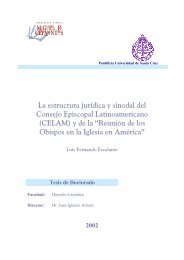You also want an ePaper? Increase the reach of your titles
YUMPU automatically turns print PDFs into web optimized ePapers that Google loves.
Anales galdosianos [Publicaciones periódicas]. Año XII, 1977<br />
The Ghostly Lover: The Portrayal of the Animus in Tristana<br />
Kay Engler<br />
When Benito Pérez <strong>Galdós</strong>' Tristana first appeared in 1892, his fellow novelist and critic Emilia<br />
Pardo Bazán proclaimed <strong>Galdós</strong>' pathetic tale of a young girl's seduction and enslavement at the<br />
hands of a decadent don Juan and the ultimate failure of all her attempts at self-liberation and self-<br />
realization as the promise of a great novel never written. She chided <strong>Galdós</strong> for abandoning his theme<br />
(the moral slavery of women), for leading the reader astray through extraneous adventures (the affair<br />
with Horacio), and for failing to fulfill the promise of his central characters (a strong-willed, self-<br />
aware Tristana; an authentically evil, monstrous Don Lope). But Pardo Bazán correctly perceived that<br />
the essence of the novel was not Don Lope's seduction of Tristana, nor the love affair with Horacio,<br />
nor her incapacitating illness, nor her final marriage to Don Lope, but rather a woman's struggle<br />
for self-awareness and self-realization. In Doña Emilia's words: « El asunto interno de Tristana,<br />
asunto nuevo y muy humano, pero imperfectamente desarrollado, es el despertar del entendimiento<br />
y la conciencia de una mujer sublevada contra una sociedad que la condena a perpetua infamia y no<br />
le abre ningún camino honroso para ganarse la vida... » 157<br />
As an ardent feminist and a champion of the rights of women in her own society, Pardo Bazán<br />
saw Tristana's struggle for self-awareness, liberation and self-realization in sociological terms. The<br />
«awakening of consciousness» she speaks of is what contemporary feminists call «the raising of<br />
consciousness» to the realities of woman's position in society. Society and its institutions are to blame<br />
for Tristana's initial predicament and, it is implied, for her own personal failure at self-liberation. It<br />
seems clear that Pardo Bazán, in criticizing <strong>Galdós</strong> for abandoning his original intent and for not<br />
allowing Tristana to become an independent woman, is not really judging the novel on its own terms<br />
but is, in fact, criticizing <strong>Galdós</strong> for not having written the novel she herself would like to have written.<br />
Clarín disagreed profoundly with Doña Emilia about the novel's value and purpose. He saw the novel,<br />
not as an account of a woman's frustrated attempt to free herself from moral slavery, but rather as «<br />
la representación bella de un destino gris atormentando un alma noble, bella, pero débil, de verdadera<br />
fuerza sólo para imaginar, para soñar, de muchas actitudes embrionarias, un alma como hay muchas<br />
en nuestro tiempo de medianías llenas de ideal y sin energía ni vocación seria, constante, definida »<br />
157 Emilia Pardo Bazán, « Tristana » in Obras completas , vol. 3 (Madrid: Aguilar, 1973), p. 1120.<br />
118

















